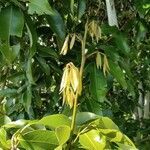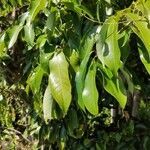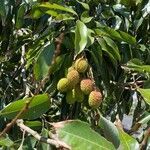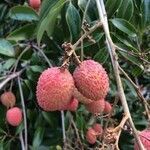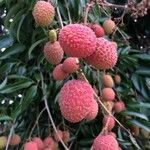Trees, evergreen, often less than 10 m tall, sometimes to 15 m tall or more. Bark grayish black; branches brownish red, terete, with dense white lenticels. Leaves with petiole 10-25 cm or longer; leaflets 2 or 3(or 4) pairs; petiolules 7-8 mm; blades adaxially deep green and shiny, lanceolate or ovate-lanceolate, sometimes elliptic-lanceolate, 6-15 × 2-4 cm, thinly leathery or leathery, abaxially glaucous, glabrous, lateral veins often slender, conspicuous or slightly prominent abaxially, margin entire, apex cuspidate or shortly caudate-acuminate. Inflorescences terminal, large, many branched. Pedicels 2-4 mm, slender, sometimes short and stout. Calyx golden tomentose. Stamens 6 or 7, sometimes 8; filaments ca. 4 mm. Ovary densely tuberculous and hispid. Fruit usually dark red to fresh red when mature, globose to subglobose, 2-3.5 cm. Seeds thoroughly covered by fleshy arillode. Fl. spring, fr. summer.
A medium sized evergreen tree. It grows up to 15 m tall but can be 35 m tall. It has a dense round crown. The trunk is smooth and grey with brittle trunk and branches. The trunk can be 1 m across. Leaves are shiny and light green. The leaves are reddish when young. They are leathery and divided into 4-8 leaflets. The leaflets are oval and taper to the tip. The flowers are pale green and in loosely branched groups at the ends of branches. It bears bunches of rough skinned pinkish fruit 3-4 cm across. These droop in clusters. There are 3 subspecies ssp. chinensis, ssp. philippinensis, ssp. javensis. There are many cultivated varieties.

